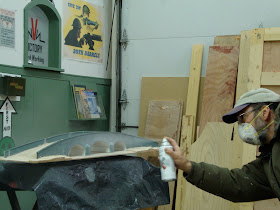Although I've made my self pretty clear of how I feel about the lack of artful sculpting or imagination that typifies the 54mm figures of BMC/Americana I know that I've also mentioned how much I enjoy the buildings and other ancillary items that they manufacture. One of the aspects of those items which I really enjoy is the ease with which they can be modified, improved, or totally kit-bashed into something else (as you can see here).
The bookstore at Antietam National Battlefield asked me to modify a BMC/Americana Burnside Bridge to make it a little more high end. This was my second such project (the first of which you can view here) and I'm fairly happy with how it turned out.
Using two copies of the stock item, I combined parts of both to achieve a thicker, more robust, model, more representative of the actual bridge.
In this detail it is clear that bridge sidewalls from both kits are "welded" together along the top. I used a soldering iron with a flat tip and established a melting pattern that was similar to the wooden coping on the historic bridge. Doubling the sidewalls really fixes one of the main beefs of this kit, that it's so scrawny-looking compared to the real thing.
I also expanded the width of the roadbed to bring the scale a little more into line with the real thing. The panels comprising the road surface were split and spaced apart by an inch. It makes quite a difference in the appearance of the bridge and will better accommodate the passage of wagons and limbers. The bridge itself is mounted on a nice sheet of 3/16 oak plywood.
Another eyesore in the original is the open, un-ceilinged arches - as seen on the far right. using sheet styrene I hot glued ceilings into place. Hot glue is particularly effective with this combination of plastics.
Here, the combined sidewalls encompass the widened roadbed which is covered with a layer of Liquid Nails and over-dusted with fine sawdust. While still soft, I impressed wagonwheel ruts and horse hoof prints lightly into the surface.
Creek bank landscape is comprised of layers of plywood shaped, glued, and clamped into position. These also provided a footing allowing the bridge to be securely glued to the base as seen below:
With all of the structural components glued and puttied it came time to spray a light coat of primer over the whole thing.
Here is the primed bridge ready for painting. Note that fine sawdust was used to texture the creek banks as well as the road bed.
Using acrylic paints the finishing was pretty straight forward.
Here, the paint is curing, afterwhich a two-part acrylic glaze was applied on the creek surface to simulate water.
Though not fool-proof this glazing stuff can provide a very satisfying effect.
And here's the finished piece, ready for delivery.
I like it.
See you in June.
Soldier on!
Mannie












Bravo! Looking forward to seeing figures on the bridge. It looks to scale for 1/32 and that takes up some space.
ReplyDeleteScott